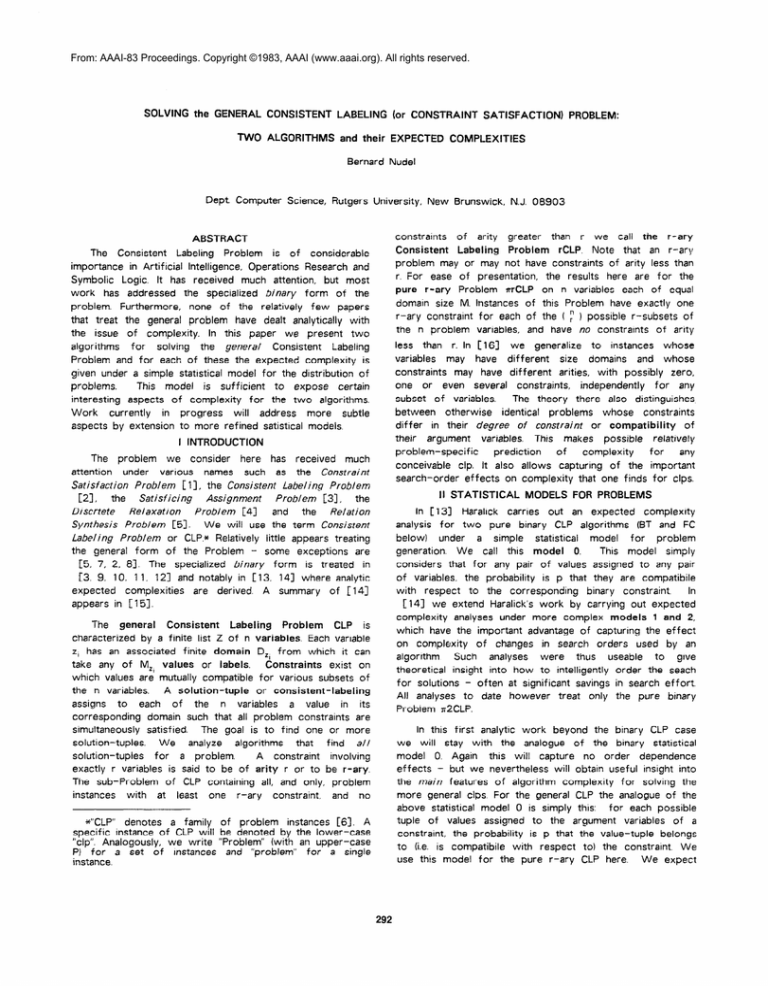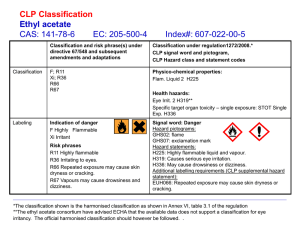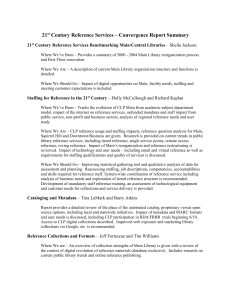
From: AAAI-83 Proceedings. Copyright ©1983, AAAI (www.aaai.org). All rights reserved.
SOLVING
the GENERAL
CONSISTENT
TWO ALGORITHMS
LABELING
(or CONSTRAINT
and their EXPECTED
SATISFACTION)
PROBLEM:
COMPLEXlTlES
Bernard Nude1
Dept
Computer
Science, Rutgers University, New Brunswick,
N.J. 08903
The Consistent Labeling Problem
is of considerable
importance in Artificial Intelligence, Operations Research and
constratnts of arity greater
than r we call the r-ary
Consistent
Labeling
Problem
rCLP. Note that an r-ary
problem may or may not have constraints of arity less than
Symbolic Logic. It has received much attention, but most
work has addressed the specialized binary
form of the
problem. Furthermore,
none of the relatively few papers
r. For ease of presentation, the results here are for the
pure r-ary
Problem arCLP on n variables each of equal
domain size M. Instances of this Problem have exactly one
that treat the general problem have dealt analytically with
the issue of complexity. In this paper we present two
algorithms
for
solving the general
Consistent
Labeling
Problem and for each of these the expected complexity is
given under a simple statistical model for the distribution of
problems.
This model is sufficient
to expose
certain
interesting aspects of complexity for the two algorithms.
Work
currently
in progress
will address
more
subtle
aspects by extension to more refined satistical models.
r-ary constraint for each of the ( y ) possible r-subsets of
the n problem variables, and have no constraints of arity
ABSTRACT
less than r. In [ 161
variables may have
I INTRODUCTION
problem
we consider here has received
much
under various names such as the Constraint
Satisfaction
Problem
[ 11, the Consistent
Labeling
Problem
121,
the
II STATISTICAL
Assignment
Problem
whose
whose
conceivable clp. It also allows capturing of the important
search-order
effects on complexity that one finds for clps.
Problem
[ 31,
the
and
the
Relation
Synthesis
Problem
[S].
We will use the term Consistent
Labeling
Problem
or CLP.* Relatively little appears treating
the general form of the Problem - some exceptions are
[5, 7, 2, 81. The specialized binary
form is treated in
[3, 9, 10, 1 1, 123 and notably in C13, 141 where analytic
expected
complexities
are derived. A summary of I: 141
appears in [15].
Satisf icing
Relaxation
to instances
domains and
constraints may have different
arities, with possibly zero,
one or even several constraints,
independently
for any
subset of variables.
The theory there also distinguishes
between
otherwise
identical problems
whose constraints
of constraint
or compatibility
of
differ
in their degree
their argument
variables. This makes possible
relatively
problem-specific
prediction
of
for
complexity
any
The
attention
Discrtete
we generalize
different
size
MODELS
FOR PROBLEMS
In [ 131 Haralick carries out an expected
complexity
analysis for two pure binary CLP algorithms (BT and FC
below)
under a simple
statistical
model
for
problem
generation. We
call this model
0.
This model simply
considers that for any pair of values asslgned to any pair
of variables, the probability is p that they are compatibile
with respect to the corresponding
binary constraint.
In
[ 141 we extend Haralick’s work by carrying out expected
complexity analyses under more complex models 1 and 2,
which have the important advantage of capturing the effect
[4]
The general
Consistent
Labeling
Problem
CLP is
characterized by a finite list Z of n variables. Each variable
z, has an associated finite domain D,, from which it can
take any of M,, values or labels.
Constraints
exist on
which values are mutually compatible for various subsets of
the n variables.
A solution-tuple
or consistent-labeling
assigns to each of
the n variables
a value in its
corresponding domain such that all problem constraints are
simultaneously satisfied.
The goal is to find one or more
solution-tuples.
We
analyze
algorithms
that
find
all
solution-tuples
for
a problem.
A constraint
involving
exactly r variables is said to be of arity r or to be r-ary.
The sub-Problem
of CLP containing all, and only, problem
instances with at least one r-ary
constraint,
and no
on complexity
of changes in search orders used by an
algorithm
Such
analyses
were
thus useable
to
give
theoretical insight into how to intelligently order the seach
for solutions - often at significant savings in search effort
All analyses to date however treat only the pure binary
Problem n2CLP.
In this first analytic work beyond the binary CLP case
we will stay with the analogue of the binary statlstical
model 0. Again this will capture no order dependence
effects - but we nevertheless will obtain useful insight into
the main features of algorithm complexity for solving the
more general clps For the general CLP the analogue of the
above statistical model 0 is simply this: for each possible
tuple of values assigned to the argument variables of a
constraint, the probability is p that the value-tuple belongs
to (i.e. is compatibile with respect to) the constraint. We
use this model for the pure r-ary CLP here.
We expect
++“CLP” denotes a family of problem instances C61. A
specific instance of CLP will be denoted by the lower-case
“clp”. Analogously, we write “Problem” (with an upper-case
P) for a set of Instances and “problem” for a single
instance.
292
shortly to complete the analysis for the fully general CLP,
under this and the more refined statistical models 1 and 2
Results under the model 2 will provide theoretical insight
2
Do for all xk e DXk
into order effects
in the general case analogous to those
made available in [ 141 for the pure binary case, as well as
providing the analogous precision in predictrng a problem’s
3
&
4
lf gCheck( k A,
1
In [ 131 Haralick empirically compares seven different
algorithms
for
solving
pure
binary
clps.
For
the
experiments
he conducted
the
ranking
of
algorithms
obtained was essentially:
best = wFC > FC > BM > PL > FL > BC > BT = worst
the abbreviations denoting algorithms are as used in
In particular, BT denotes the Backtracking algorithm
[ 17, 181, FC denotes the Forward
Checking
algorithm and
) + “xk Wipe-Out”
**We use square brackets
lrst or vector.
some variables
c . 1 throughout
Do for i = 1 to mk
3
If v,,(
A,
) c T,,
5
end
6
Return
7
end gCheck
“No xk wipe-out”
gBT and its subroutine gCheck
D )
2
Do for all x, e D,,
3
&-Ak-,
4
If k < n then Do
11 &,I
5
D’ -
6
If D’ + “D, wipe-out”
gfilterl k D Ak 1
then gFC( k+ 1 Ak D’ )
end
eke print &
10
end
11
end gFC
1
gFilter( k D Ak )
Do for all f e F,
3
Do for i = 1 to mkf
4
Do for all f e Df
-If v,,,( A, f ) e T,,,
5
6
then D, -
7
Df -
[?I
end
If D, = 0 then return
8
9
“D, wipe-out”
end
10
are In
Ak 1
then return “j& wipe-out”
2
In gBT all domains D, remain unchanged
of
gCheck( k Ak )
8
to a path through the search tree.
Note that the node for
not actually
be
a given instantiation sequence A,+,
may
generated due to the discovery of a violation of problem
constraints at an earlier node Ak c Kk+, on that path. This
is in fact where the usefulness of such algorithms arises
since attempts to generate any candidate solution-tuples
containing xk are then avoided. Initially for both alorithms k
In gFC domains
1
2
9
for the variables of A,. lt is
. ,, 1 of values x, E D,
built up in these algorithms’ using 1 1 the list concatenation
operator.
Such an instantiation
sequence xk
corresponds
and are global
end gBT
7
and gFC. At all k-th
level nodes in either algorithm,
instantiations or value assignments have been made for the
same ordered sequence Ak = [ x1 x2 .
xk ] Of the first
k variables of (globally available) list X. Nodes at level k are
to
different
correspond
in that
they
distinct
only
An instantiation
instantiations made to the variables of A,.
[X&.
=
sequence for the variables of A, is a list Ak
= 0.
8
gFCI k -ij;,-,
Common
to both algorithms
is the notion of an
instantiation
order**
X = I: x1 x2
xn ] being some
permutation of the conventionally ordered problem variables
z = [ Zl 22
z, 1. By definition, a k-th level node of
the gBT or gFC search tree is formed when variable xk is
its
from
value
some
(assigned)
instantiated
to
j7k
corresponding domain DXk - this happens at lines 2 of gBT
gBT( k+l
eke print &
end
Figure Ill-l
respectively we present recursive versions of our general
Backtracking
(gBT) and general Forward
Checking (gFC.1
These are quite
clps.
algorithms for solving arbitrary
of the corresponding
pure binary
natural generalizations
algorithms BT and FC, which we now rename to be n2BT
and n2FC.
1, A,-,
11 &I
7
4
wFC is a variant of FC we call word-wise
Forward
Checking
that exploits
the bit-parallelism
available
in
machines. FC and wFC
seem to have been
present
independently discovered
by Haralick [ 131 and McGregor
[ 121, but in fact FC also appears in the earlier paper of
Golomb and Baumert [ 171 where
it is referred
to as
In figures Ill- 1 and Ill-2
Backtracking
with preclusion.
=
-&-,
6
III ALGORITHMS
c141.
)
then if k < n then
5
complexity.
where
gBT( k xk-,
end
11
D’ -
12
Return
[ DXk+, DXk+2 .. D,” ]
13
end gFilter
D’
to denote a
Figure Ill-2
293
gFC and its subroutrne gFilter
general updated
in
argument
D = [D,,DY2.
returning
“D, wipe-out”
as soon as one occurs However
for the pure binary clp, mkf = (:I: 1 = 1 and only the order
of selection of f from F, is an Issue. This is the case
studied in c 141 where we use the theory to suggest global
and local Consistency-check
Ordering (CO) heuristics for
at
each node and are passed as an
the
vector
of
domains
.D, r! 1. Testing tuples of instantiations
for compatibility with respect to constralntscrs denoted as a
test of membership of the tuple in the set of compatible
tuples for the corresponding
constraint (line 3 of gCheck
and line 5 of gfilter1. In practice these tests will usually be
carried
out on a constraint
defined
intensive/y
via a
ranking the f of F,.
However when mkf f 1 the question
becomes how to rank the pairs (f il. If the statistical model
as a set. The
procedure
rather than defined extensive/y
algorithm and our analysis below are compatible with both
of merging the loop at line 4 as well with those at lines 2
were
and 3.
QBT:
At
a
level
k
node
the
current
instantiation
xk is tested for compatibility with respect to
all mk constraints that involve xk and some of the k- 1
variables of A, besides xk. Note that Clck<n ( !I,’ 1 = ( : 1
as required. The i-th constraint tested- cf no wipe-out
prevents it) at each level k node we denote T,,. Its list of
argument variables we denote by vki. The corresponding list
Of Values for these variables, given the assignments Of A,,,
is denoted vki( z;k I. This is simply the projection of xk
=
onto vk,. For example if A, = [ z3 z6 z2 zg z4 1, A,
In addition to A,,
under the present
simple statistical model
IV ANALYTIC
RESULTS
Under statistical model 0 it is easy to determine the
probability P(clp) of a given problem clp - analogously to
the model 1 result for the r = 2 case given in [ 14). In
terms of P(clp) we can define the expected total number
=
of nodes in a search tree (for a given algorithm) as N
&,
N(clp) P(clp) where N(clp) is the actual total number of
nodes generated for problem clp.
Similarly, the expected
total number
of
consistency-checks
performed
in the
search tree (for a given algorithm) is by definition c
[ e a e g b 1 and the argument-list
for constraint vki is
Cz~z4Zgl,then&i(&J
=
[eba].
Given
the
instantiations of A k-1, the current instantiation izk violates
constraint T,, if vk;i ‘;li;, ) B T,, and this is tested at line 3
of gCheck.
gFC:
However
ordering X is irrelevant on average under model 0. For
individual problems though a good ordering can lead to
significant savings, and our more refined model 1 and 2
analyses of [ 141 capture this effect
for the pure binary
case. These theories
are then used there to suggest
Instantiation
Order
(IO)
theory-based
global and local
heuristics that are found to be quite effective
in reducing
the complexity of problem solving.
earlier variables of A,. For a pure r-ary clp mk = (!I: )
since this is the number of possible r-ary constraints over
xk and r-l
other variables to be chosen from the k-l
Algorithm
enough one might even study the advantages
0, the nesting of loops shown is optimal, and any residual
indeterminism
is
irrelevant
(with
respect
to
average
complexity) in either algorithm. In particular, the instantiation
representations.
Algorithm
refined
gFC also uses F, =
x, 1 the list of future variables,
or not
c xk+l xk+2
yet instantiated variables, at level k. At a level k node, each
future variable f e F, has each of its potential future
instantiations ? e D, (as contained in D, the list of updated
domains for future variables) tested for compatibility with
respect to ali mkf constraints that involve xk, f and some
of the k- 1 earlier variables of A,.
For pure r-ary clps,
&,
C(clp) P(clp) where C(clp) is the actual total number 0:
checks for problem clp. These expressions are not useful
as they stand since N(clp) and C(clp) are not known
analytically. However they can be tranformed
into useable
expressions. We can use
mkf = ( :Zi 1 since this is the number of possible r-ary
constraints over variables xk, f and r-2 other variables to
be chosen from the k-l
variables of A, besides xk. Note
that since there are n-k future variables f at level k, there
is for the pure r-ary CLP ( n-k )( !I:
) new constraints to
check at level k and c tskln ( n-k I( 112 ) = ( : ) as
required. The i-th such constraint involving f, tested at each
level k node (if no wipe-out prevents it) we denote T,,,. Its
list of argument variables iS vkf, and the list of values
assigned
respectively
to
these
variables
given
the
instantiations of Nk and the value 7 being tested for f, we
denOteIkfi(
ii, f 1. Given zk, value i violates constraint
T kf, if vk,,( A, f 1 B T,,, and this is tested at line 5 of
gfilter.
Lack of compatibility leads to ? being removed or
filtered
from its domain D,. The sample trace for 2FC
appearing in fig 4 of [ 141 may be helpful.
where
N(k clp) and C(k clp) are respectively
the actual
number of nodes generated and checks preformed
at the
k-th level in problem clp. In terms of these we can define
the expected number of nodes and checks at the k-th level
of the search tree, given by
Nklp) = &#n
N(k clp)
N(k) = cclp Nlk clp) Plclp)
and
and
Ciclp) = c Isksn C(k clp)
c(k)
= c,,,
The expected totals are then expressible
at a level summed over all levels
Fi =c
1 Sk%
m(k)
and
c
C(k clp) P(clp)
as the expectation
= c Isksn c(k)
By successive transformations
of this kind, the following
expected-value
expressions
are obtained in [ 161.
As
mentioned, for notational simplicity we present results for
the pure r-ary
CLP on n variables each variable having
equal domain size M. We expect to present in [ 161 the
fully general result under more refined statistical models 1
and 2.
Note that the selection order for f E F, at line 2 of
gFilter may be a function of level, or even a function of
the node. In fact one could generalize the algorithm by
merging the loops at lines 2 and 3 of gFilter to give
Do for (f i) E F, X i 1 to mkf ) in some order
294
Algorithm
gBT
k-l
families of curves are shown, corresponding to three ways
In which n varies with the independent variable r.
)
N(k) = Mk p’ r
(1)
c(k)
(2)
= N(k) c(k)
,Z(k) = [ 1 - p’ 1::
Algorithm
)
l/Cl-PI
The n = c family: Curves for n = 5 and n = 10 are
shown. As expected these curves generally increase with r
since when r > n no constraint can be tested before
termination of either algorithm
Both gBT and gFC then
generate the same full search tree of all II&S”
Mk nodes
so that Narc / Iv,,,
= 1.
(3)
gFC:
m(k) = Mk p( k
r ) [ 1 - ( 1 _ p( Fz: 1 )M In-k
c’(k) = m(k) E(k)
The n = cr family: Curves for n = lr, 3r/2, 3r
are shown
In contrast to the n = c family, these
generally decrease with r - in other words the
advantage of gFC compared to gBT becomes even
as r grows.
(5)
For either algorithm, c(k) is the expected number of checks
performed
at a node generated at leve! k. An expression
for E(k) of gFC still remains to be determined.
We can use
The n = r + c family: Curves for n = r+O, r+ 1, r+3,
r+ 10, r+ 15 and r+30 are shown. This family shows the
behavrours of both the above two families of curves. For
the above results to compare gBT with gFC in terms of the
relative number of nodes the algorithms generate. Figure
IV- 1 shows the ratio N,,c / N,,,
of the expected
totai
number of nodes generated by the two algorithms. The
problems solved are characterized
by parameters p, n, M
and r. We
consider
the case that M = n at two
“reasonable” values of p: 0.5 and 0.75. In both cases three
2/ 4
In=r+30
p = 0.5
and 5r
curves
relative
greater
the smaller c values
c values the curves
larger r In any case,
hence the relative
remains large.
these curves decrease with r. At larger
first increase with r but level off at
the ratio m,,c / mgBT stays small and
advantage of gFC compared
to gBT
8
r
M = n
p = 0.75
Figure IV-1 Analytic comparison of gFC and gBT for solving pure r-ary
295
M = n
clps
II61
Note that as P goes to 1, both algorithms will be
increasingly unable to find inconsistent search paths and, as
above,
both wil! generate
full search trees
with the
maximum number of nodes at each level. In this limit
therefore, N arc = $3T
and ail curves
collapse
to be
horizontal at value N,,c / NgBT = 1. This ef feet however
requires p very close to 1. Even at p = 0.99 we have
found that the advantage of gFC over gBT is often still
signif icant.
Haralick,
R. M.,
Davis,
Rosenfeid,
L. s.
and
A. “Reduction operations for constraint satrsfaction.”
Information
Sciences.
14 (I 978)
199-2 19.
L-81
Haralick,
labeling
( 1980)
cg1
Cl01
will
the
Cl II
still outstanding c(k) of gFC.
ACKNOWLEDGEMENTS
Many
thanks
to
my
Ph.D. committee
-
Saul
I21
Haraiick,
labeling
R. M. and Shapiro,
problem:
Part
I.”
Analysis
(19791
c31
and
Machine
J.,
of
c51
Computer
Comm.
E. C.
ACM.
Sot.
for
Montanari,
properties
U. “Networks of
and applications
Toronto,
f nformation
Sciences.
Mackworth,
Relations.”
99-l 18.
Artificial
A. K.
Computational
Ontario,
Studies
constraints
to picture
7 ( 1974)
of
1978,
95-
“Consistency
Intelligence.
fundamental
processing.”
132.
in
Networks
of
8
(1977)
and
Intelligence.
14
(I 980)
Nudei, B. A. “Consistent-labeling
problems and their
algorithms.”
In Proc.
National
Conf.
Artificial
Pittsburg, 1982, 128- 132.
intelligence.
Cl61
Nudei, B. A., title
Dept. Computer
appear
Cl81
to
be
Science,
decided,
Rutgers
PhD dissertation,
U., 1983,
To
Goiomb,
S. W. and Baumert,
L. D.
“Backtrack
programming.” J. Assoc. Computing
Machinery.
12
(1965)
296
G. L
“Increasing tree
satisfaction
constraint
Cl51
r171
“Synthesizing constraint expressions.”
2 1 (1978) 958-966.
Elliot,
for
Nudel, B. A. “Consistent-labeling problems and their
algorithms:
expected-complexities
and theorybased heuristics.” Artificial
lnteliigence.
2 1: 1 and
2 March (1983)
Special issue on Search and
Heuristics, in memory of John Gaschnig; This issue
is also published as a seperate book.
Search and
Heuristics, North-Holland, Amsterdam 1983.
PhD
Carnegie-
Rosenfeld,
A., Hummei, R. and Zucker,
S. “Scene
labeling by relaxation
operations.”
/ EEE
Trans.
Systems,
Man
and
Cybernetics.
SMC-6
(1976)
420-433.
Freuder,
Canadian
Intelligence.
L-141
solving
“The consistent
Sciekze,
Gaschnig, J. “Experimental case studies of backtrack
new algorithms for satisficlng
vs. Waltz-type
vs.
assignment problems.” In Proc. 2-nd
National
Conf.
Haraiick, R. M. and
search
efficiency
Artificial
problems.”
263-313.
Artificial
measurement
alfforithms.
193-203.
229-250.
IEEE
Trans.
Pattern
Intelligence.
PAMI- 112
Performance
certain
search
dissertation,
Dept
Mellon U., 1979.
141
L. G.
for
Trans.
Pattern
I ntel I igence.
PAMI-2:3
Machine
Cl31
173-184.
Gaschnig,
analysis
A system
procedures.”
120.
and
“The consistent
McGregor,
J. J.
“Relational consistency algorithms
and their application in findlng subgraph and graph
isomorphisms.”
Information
Sciences.
19
( 1979)
References
Fikes, R. E.
“REF-ARF:
problems
stated
Intelligence.
1 ( 1970;527-
R. M. and Shapiro, L. G.
problem,
Part II.” IEEE
Cl21
Amarei,
Martin Dowd, Marvin Pauli and especially my supervisor
William Steiger - who strongly suggested I generalize to
arbitrary arity constraints. Without their “encouragement” this
paper may never have been written.
IllI
and
c71
Analysis
0 to analytically compare
algorithm a2FC against
and n2FC against n2wFC.
We
expect
that the
corresponding
comparison
for the pure r-ary
case
soon be possible, once we obtain an expression for
M. R. and Johnson, D. S. Computers
Freeman, San Francisco, 1979.
Intractability.
It was however pointed out in [ 131 that c, not N,
is
the appropriate measure of complexity for these algorithms.
For the pure binary case we have in [ 141 used c
under
model
x2BT
Garey,
516-524.
M. “Backtrack
Bitner,
J. R.
and
Reingold,
ACM.
18 (1975)
pr501gr;rn;ing techniques. n Comm.




